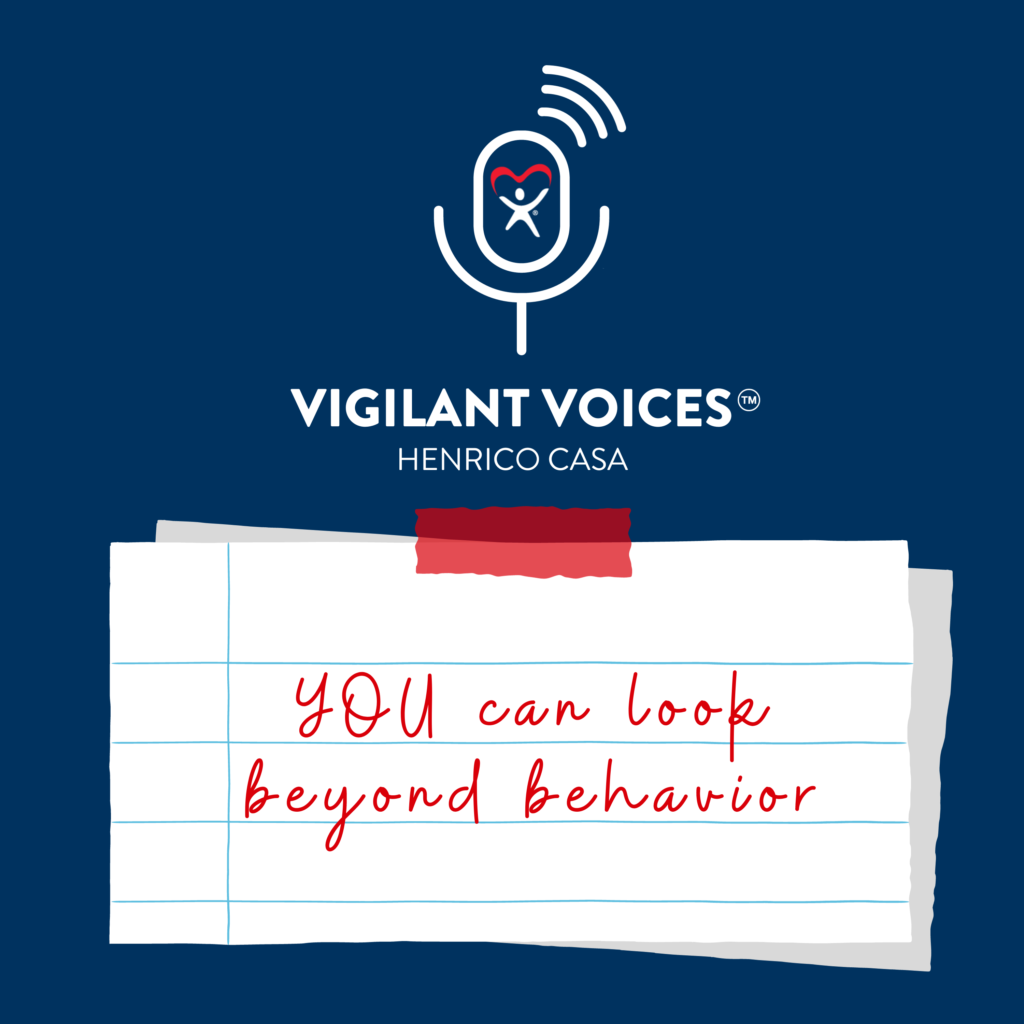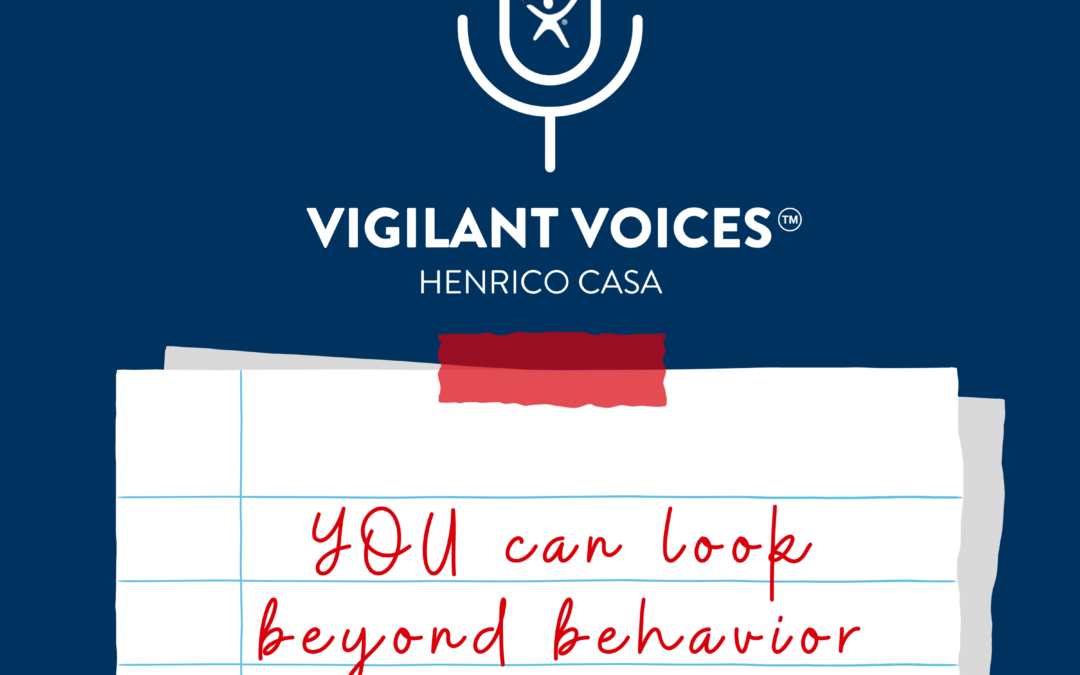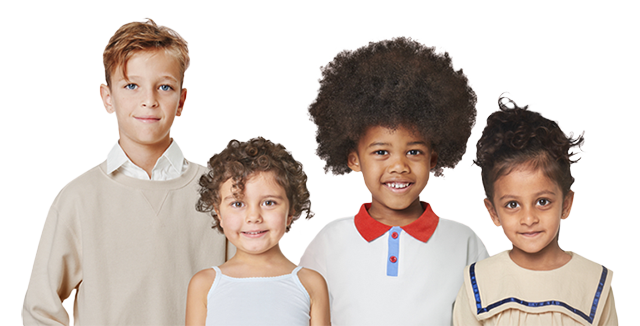
Listen to Episode 17 of the Vigilant Voices™ podcast, YOU Can Look Beyond Behavior.
Jeannine Panzera: Hello, listeners. We’re glad you’re here with us for another episode of Vigilant Voices.
Kristin Blalock: Yes. We’re so grateful to be on this journey together with you, listeners, to explore how we can give every child the support they need to reach their full potential.
J: Right. We want all of us to know about the many challenges facing children and families in order to help create a community where one day no child will face abuse, neglect, or trauma.
K: Yeah. And not only that they’re safe, but also that these children have the support they need to heal.
J: Right. And knowing what they need to heal often requires that we have to look deep beneath the behaviors that they may be exhibiting to see those real needs that need to be addressed in order to move forward in a healthy way.
K: Right. What’s that saying? That kids who need the most love will ask for it in the most unloving of ways?
J: That’s it. And it can be incredibly frustrating. Right. It’s that same idea for physical sickness, let’s say. You see symptoms like a cough, but what is actually going on to cause that cough? Cough medicine may help it, but then if it doesn’t get better, doctors might need to identify the actual cause to make that person yeah. The symptoms are masking the underlying issue.
K: Right. And so today we’re going to talk through the question, what is this child’s behavior telling me?
J: Which is really a fantastic question, but Kristin, I know you have a CASA case story for us.
K: Yes. This is the story of a boy we’ll call Mark. Mark was identified as a teenager who needed a Court Appointed Special Advocate as a result of some criminal activity he was involved in.
J: Right. And this would clearly be an example of poor behavior that Mark is exhibiting. Right?
K: Yes. Behavior that we assumed was caused by an underlying unmet need. Not only was Mark involved in criminal court proceedings, but also family court because his caregivers were seeking to be relieved of custody, which is legal jargon. But basically, Mark’s behaviors had just become too much for them to handle, and they no longer thought they were safe sharing a home with him.
J: And that’s sad on a lot of different levels.
K: Yeah. As is with so many kids who’ve experienced trauma. If someone is not looking at their words and actions through a trauma informed lens, they’re likely to react to a behavior and miss the underlying need that’s driving that behavior.
J: And that, of course, doesn’t help Mark or any child like him in the long run.
K: Correct.
J: So it’s always important to note that, and I think we even talked about this a little bit in our last episode, that every child is different. Yes. And as we’ve talked about before, trauma then is going to affect every single one of the children differently.
K: And, again, Jeannine and I are not licensed mental health providers by any means. We’re in no way making diagnoses today.
J: No. Now, I feel like my legal background give some big legal disclaimer here, but without the specifics of trauma and the diagnoses, we can see correlations between behaviors and then what the potential unmet need is that’s driving that.
K: True. True. I was exploring Georgetown University’s Center for Child Development and Health website, which I’m totally going to link.
J: Yeah. Great website.
K: And I came across a list of child behaviors and what domain of development they’re related to.
J: That’s interesting. And it makes sense at first glance. We may not know the specific unmet need, but we can often tell that the behavior is related to a certain area where development may have been lacking. Physical, cognitive, language, social, emotional.
K: Yeah, exactly. So, Listener, we wanted to use our time together today to point out some behaviors and what they may be related to. First, to really drive home this idea that behaviors are just symptoms. And second, to help point you in the direction of recognizing where there may be an unmet need that is affecting a child’s development.
J: Right. So as we dive into this, some of the behaviors that initially come to my mind in our role as Court Appointed Special Advocates is a lack of trust. Yeah. We are trying to build a relationship with a child to offer support, identify their needs, potentially needs of the family. But sometimes it seems like they’re maybe even sabotaging those efforts. They’re shutting people out, just pushing them away. They’re not responding, not following up on help when help is offered.
K: Shutting down, definitely. And sometimes they may even appear combative. And if you’re looking only at the child’s behavior, you want to say, I was here to help, but never mind, dude, and throw in the towel.
J: Yeah. Which is the last thing we would want to say, recognizing that it’s frustrating. But these are all behaviors associated with what we call attachment. And so there was likely some disruption in what should have been a normal, healthy bond between the child and his or her primary caregiver.
K: Right. And so the unmet need in this example could be a lack of comfort, a lack of affection or stability. Maybe this child hasn’t had their physical and emotional needs met with consistency.
J: Right. And that’s obviously the case with the children that we serve at CASA, since they’ve all come to us and our agency as a result of child abuse or neglect.
K: Right. Okay. So here’s another behavior we see pretty often, and that is children or teens who are quick to anger and once upset, slow to calm down.
J: Yeah, we’ve probably all heard the phrase, I’ve certainly heard it in our work, that they “just flew off the handle,” don’t even know what happened. They just boom, blink. And that’s exactly what we’re talking about here with what that behavior looks like. And it’s so simple to just react to the behavior then with punishment. Right. So you acted inappropriately. Now there’s going to be a consequence, but the underlying need is really about their ability to regulate, or maybe in this case, their inability to do so.
K: Sure. So, Listener, if the word regulate or regulation is a new term for you, it’s basically referring to a child’s ability to experience moods, positive or negative, without their feelings kind of getting hijacked or their little brains getting off track. If you were with us for our recent conversation with John Richardson. Lauve, it’s that concept of children flipping their lid. Their brain stops functioning in a rational way and goes into flight, fight, or freeze mode, which would be referred to as being dysregulated,
J: which is such a common trait in kids who have experienced trauma.
K: Yeah. These children often didn’t learn self regulation. It either wasn’t modeled for them or their development in this area got kind of side-railed. Their need behind the behavior is for regulation.
J: Exactly. So another set of common behaviors we see are those that might be described as oppositional or self destructive. And these behaviors are often associated with an underlying need for control. They’re being oppositionally defiant.
K: Yeah, you’re so right. Because these kids have experienced things that were way beyond their control, whatever that might be abuse or neglect or maybe other traumas that were more accidental or environmental, like a car accident or something like that. But they didn’t have any control over what happened to them. And so now they’re behaving in a way to hold on to whatever control they can possibly grasp.
J: Right. And this can be really confusing when you think about self harm or eating disorders. Right. I mean, those are examples of negative or bad behaviors in this category. And so these children are doing something that is clearly not healthy, but the feeling of having control over their body is what they are prioritizing. And they need a sense of control in that situation.
K: And if you’re interacting with a child who’s showing these behaviors, you need to recognize that need. Giving them control over other things may take away the need to show control in such an unhealthy way.
J: Right. And, I mean, it’s clearly a sign and a call for help. And it’s also clearly a really simplistic way to talk about this. I mean, we’re glossing over big behaviors and big needs to give you listeners a high level feel for why children who have experienced trauma may be behaving in certain ways. Sure. Not all the details, but high level.
K: Okay, so in talking about this, I always want to be looking for ways we can help. Right. Like, what can we be doing to look beyond the behavior and instead nurture a child’s need?
J: Right. And any of us that are working with children with trauma – so this is our teachers, our counselors, our parents caregivers, our advocates – need to be aware and really should work to make sure that we stay regulated when these behaviors might feel triggering to us.
K: So true, Listener. Here are a few simple things we can try to do to keep our cool, which is sometimes easier said than done, of course, and respond to the deeper need. First, consider using a “time in” when children misbehave. We want to punish or isolate them. That’s kind of like our instinct. But if you yourself are able to remain calm, opt for a time in sit with a child, be present even if you say nothing. But by staying with them, you’re not shaming them or shunning them for their behavior.
J: Right. You’re recognizing that something’s wrong. But we’re going to try to de-escalate this together. I like that. I think another one might be to help children identify what they are feeling. Why that behavior manifested itself, something like the way you are speaking makes it seem like you’re mad. I wonder if you’re also feeling sad or hurt. Try to help them make connections between those behaviors and their emotions without obviously planting a seed in their mind. Over time, you may be able to take the next step to then help them connect those emotions to that underlying need.
K: Yeah, that’s right. Okay, so our third tip is to look for the good. If a child is acting out in some way, find something, find anything positive that you can point out. Gosh, I’m so glad you feel comfortable sharing your feelings with me. Sharing feelings is so important. But let’s avoid using words that are hurtful to me or to your friends or to whoever’s affected.
J: Right. And that’s actually a teaching moment. As we’re talking here, I’m thinking of another one. I’m a little bit hesitant to share it because I think this one isn’t necessarily appropriate for all situations. But hugs can go a long way for a child.
K: For sure. Safe touch can be so comforting and healing.
J: Yeah. And I think “safe” – that’s the key. And you have to know that a child would feel comfortable with a hug. Oftentimes it’s suggested that you should ask before, but I also have read things that show that a 20 second hug is therapeutic.
K: Wow. Yeah. And I think it’s providing that physical comfort when a child is behaving badly actually doesn’t necessarily reinforce bad behavior, which is often the hesitation we have in doing it. It can actually give that child love and security that they need in a moment when they’ve escalated in some way. And so it actually can help take down those barriers.
J: Yeah. And we want to reach them in their underlying need. Right. And how about Mark then, going back to our CASA story? Kristin, was there an unmet need that we ultimately were able to identify that was really behind his behaviors?
K: Yeah, of course there was. We quickly learned that there was a lot of conflict in Mark’s home and potentially some emotional neglect. We’re actually still getting to know Mark and learning about his experiences. It takes time to build a relationship where there’s trust, but there were definitely unaddressed mental health disorders that have now come to light in Mark’s recent psychological evaluation.
J: Right. So clearly, there were unmet needs that then manifested themselves in this case.
K: Yeah. And this is a great example of why having an advocate is so important to youth like Mark. He needed someone to see beyond his behavior, and he needed someone who was unbiased and who could step back to look at the big picture, all of the moving pieces in his life. Someone who could identify needs that the court can then address to set him on a better you know, merely punishing Mark again and again wasn’t going to be the answer.
J: Yeah, you’re absolutely right. And, I mean, I hear this story, and I’m very glad that Mark has an advocate speaking up for him. And then that makes me also glad that you, listener, have taken the time to learn more about the needs of children who have experienced trauma. And we always try to leave you with a call to action because we know that merely learning isn’t enough. We also have to then all be acting on behalf of these youth in our community.
K: Okay. So, Jeannine, what should we leave everyone with?
J: You would ask me that! Perhaps, let’s all work to see beyond behaviors. Pause before you react. Consider the why if there is an underlying need.
K: Yeah. Big or small. Because a child may need professional help to address a big need. But we can also help with the small ones. I need a glass of water to stay focused and regulated. I need a safe adult to take a walk with me to calm down.
J: Definitely those little things. Yeah. So look for the need behind the behavior and then focus your response on that need, and we’ll all be better for it.
K: We will.








